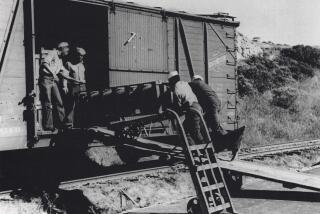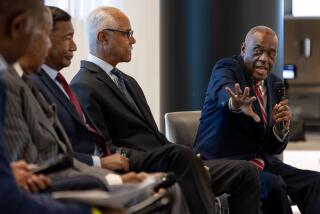George Cooper, 85; One of 1st Black Naval Officers
He would always recall walking through the train station in Chicago just hours after being commissioned as an officer in the U.S. Navy and how time seemed to stop as commuters stared--first at his crisp uniform and then with astonishment at the man wearing it. It was 1944 and the reason for their reaction was simple: No other black man had ever worn the uniform of an officer in the U.S. Navy.
*
George C. Cooper, one of the last survivors of the “Golden Thirteen,” the first group of African Americans to be commissioned as active-duty line officers in the U.S. Navy, has died. He was 85.
Cooper died May 20 at a retirement complex in Centerville, Ohio, a suburb of Dayton. He had been in failing health for some time but the cause of death was not announced.
With no plans to make history, Cooper was a chief petty officer training metal smiths for the Navy at his alma mater, Hampton Institute in Tidewater, Va., when he was summoned by his commanding officer in January 1944.
“You’ve got orders to go to Great Lakes, and I think you will not be sorry,” said Cmdr. E. Hall Downes, whom Cooper had come to consider a friend.
Arriving at the Illinois naval facility, Cooper and 15 other black sailors were told: “You know why you’re here? You are being considered for officer candidate’s school.”
One of the 16 thunderstruck men later expressed their collective reaction: “We looked at each other and thought he had lost his mind.”
Such a stunning announcement was the result of pressure from civil rights groups and a liberal politician’s efforts to soothe the troubled racial waters during World War II. By then, the wartime Navy had about 100,000 black sailors but no black officers.
Adlai E. Stevenson, the future Illinois governor and presidential candidate who was serving as assistant secretary of the Navy, won approval for his proposal to remedy that discrepancy by accelerating officer commissions for a dozen or so black enlisted men.
The 16 selectees were already proven leaders of enlisted men and, save one, had college educations. Nevertheless, they underwent rigorous screening, including background checks by the FBI, that no white officer’s candidate ever faced.
Dubbed “Navy 101,” their crash training program taught by white officers telescoped four years of courses in seamanship, navigation, gunnery, naval regulations and naval law into three months. The men’s combined home and classroom were barracks segregated from white officer candidates and black enlisted men.
Sixteen candidates were chosen for a dozen officer rankings, historians learned later, because the Navy expected a normal 25% attrition rate--or that four of the candidates would fail.
None did.
“We decided early in the game that we were going to either sink or swim together--even to the point of studying together after we were supposed to be in bed,” Cooper told Paul Stillwell, a historian for the Naval Institute, a private professional society based at the U.S. Naval Academy in Annapolis, Md., for his book “The Golden Thirteen: Recollections of the First Black Naval Officers.”
“I can remember being in those barracks and sitting in the head [bathroom] after lights out,” Cooper said, “just drilling each other back and forth until it hurt because we were convinced that if one of us made it, we were all going to make it.”
But despite the men’s 100% pass rate, the Navy remained reluctant to have too many black officers. So Stevenson’s suggested dozen were made ensigns; a 13th, apparently the man who had never completed a college degree, became a warrant officer; and the remaining three were returned to the enlisted ranks.
The “Golden Thirteen”--the number of new black officers with new gold bars--received their commissions with little fanfare, national publicity or even a graduation ceremony.
“I was the only one of the 13 who could go into the Navy store and put on a uniform and walk out with it,” Cooper said. “Everybody else had to have it altered. I was the first black man to wear a naval officer’s uniform because my size was just right.”
“Fortunately, over that weekend we had liberty, so I was going to see my wife, who was in Hamilton, Ohio, getting ready to have our baby. I walked into the railroad station in Chicago, and that whole station stood still--literally.”
Although commissioned with the war still in progress, the 13 were all given relatively menial jobs, not allowed to command white troops and kept away from combat zones. Only one of the men made a career as a naval officer.
Cooper returned to the Hampton Institute, this time as the personnel officer at the Naval Training Center. And while the trainees were both black and white, most of the officers were white and Cooper encountered the inevitable racism.
“Many [white sailors] simply refused to salute. If they’d see me coming, they would cross the street and get on the other side.”
He said he became agitated only once--when a sailor stopped within a foot of his face as he was walking with his wife and daughter in Newport News, Va., and said to him: “You black SOB, I read about you guys, but I never thought I’d meet one.”
Cooper said he started to go after the sailor, but was stopped by his wife, who told him it wasn’t worth it. He agreed, calmed himself and thanked her.
Eventually, Cooper was ordered to go to the Pacific. He never made it, however, because of a back injury he received during basic training at Great Lakes. He received a medical discharge and continued teaching and assisting veterans at Hampton for a number of years.
Born in Washington, N.C., Cooper was one of 11 children. His father, who ran a sheet metal shop, and his homemaker mother barely completed grade school but lived to see all of their 10 surviving children get college educations.
Cooper earned a vocational education degree at Hampton Institute, married and began his teaching career at an Ohio university. But when war broke out, he returned to Hampton to train Navy metal smiths and soon enlisted to keep the job.
After his years in the Navy and at Hampton, Cooper moved back to Ohio in the early 1950s to work as a Dayton housing inspector, and then as Antioch College’s director of its international work-study program.
In the late 1960s, he became the first black person to run a Dayton city department when he was appointed director of Human Resources. Until his retirement in the early 1980s, he managed more than 900 people in seven divisions handling corrections, housing, health, consumer protection, parks and recreation.
Stillwell, the “Golden Thirteen’s” historian and a retired Navy commander who served in Vietnam, became a close friend of Cooper’s and described him as “a warm and generous man.” He said despite Cooper’s failing health, he remained an engaging speaker intent on improving race relations in western Ohio, where he spent much of his adult life.
“He said that each of us has an obligation to help those coming behind and he lived those beliefs till the end,” Stillwell said.
With the death of Cooper, only three of the “Golden Thirteen” survive. There are, however, now more than 3,000 black officers in the Navy.
Cooper is survived by his wife, Margaret of Centerville, Ohio; a daughter, Peggy Cooper Davis of New York City; and a granddaughter.
More to Read
Sign up for Essential California
The most important California stories and recommendations in your inbox every morning.
You may occasionally receive promotional content from the Los Angeles Times.










